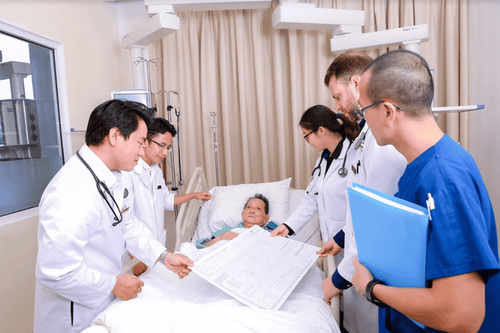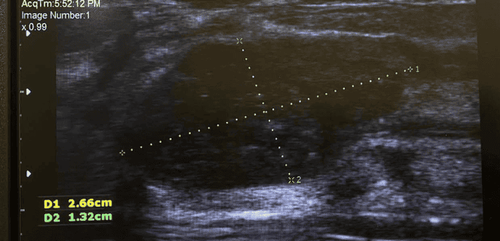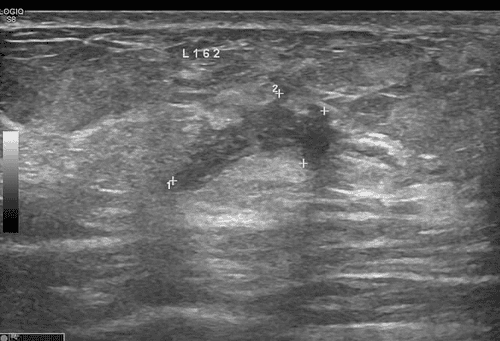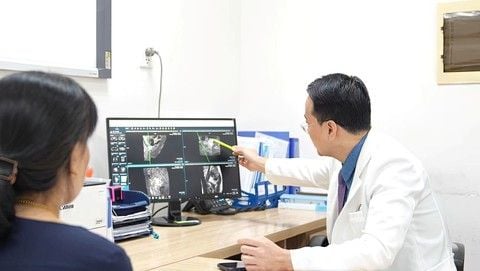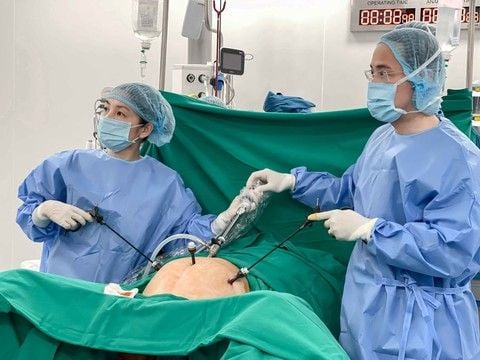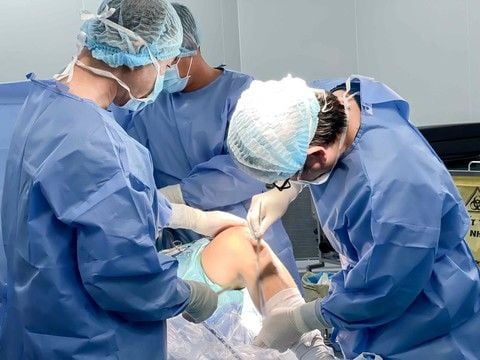It’s often assumed that cancer, perceived as a "death sentence," will crush a person’s spirit, leading them to give up from the start. However, in reality, many cancer patients overcome despair and the shock of their diagnosis to move forward with determination and hope.
1. A Brave Young Warrior’s Journey With Bone Cancer
Thirteen-year-old Tran Yen Nhi from Hoang Mai, Hanoi, is a cheerful and lively girl. In January 2021, she began experiencing leg pain after a minor collision with a classmate. By February 2021, she was diagnosed with bone cancer in the upper part of her right tibia.
This "young warrior" shared that after her mother took her to multiple hospitals, the family received the devastating news of her cancer diagnosis. Initially, her mother chose not to tell her. “When I found out, I borrowed my mom’s phone to research bone cancer. I learned about the three treatment options: surgery, chemotherapy, and radiation. I realized my condition wasn’t as severe as others because my leg wasn’t as swollen as some patients I saw during hospital visits,” Nhi explained after undergoing surgery to replace her tibia at Vinmec Hospital. Prior to surgery, she had completed six rounds of preoperative MAP chemotherapy.
Yen Nhi's mother recalled that the COVID-19 pandemic disrupted Nhi's treatment journey. During 28 days at home, Nhi faced the risk of her condition worsening, yet she became a source of strength for the entire family.
“Nhi often researched her condition and encouraged me whenever I felt down. She’d say, ‘This disease is treatable, Mom, but we need to stay positive.’ Sometimes, when the pain was intense, she wouldn’t even complain because she didn’t want me to worry more. She wasn’t embarrassed about her hair loss and wasn’t afraid of being teased by her friends,” Ms. Cuc said.
However, Yen Nhi’s journey battling cancer wasn’t without tears. Many times, the pain brought her to tears as she clung to her mother or her doctors. Yet, these moments were fleeting, as Nhi quickly found her inner strength to persevere. Doctors at Vinmec Hospital fondly remember her as “a girl whose body may not be strong, but whose spirit is incredibly resilient—witty, cheerful, and optimistic.” It was this optimism that inspired her mother and strengthened the resolve of her medical team.
Following her surgery at Vinmec Hospital, Nhi continued chemotherapy and completed her treatment two months later. Today, she walks normally, rides a bike with ease, and even plays badminton. Her latest check-up showed no signs of recurrence or metastasis.
2. A Young Woman’s Journey From Bone Cancer to a New Beginning
March 2, 2023, was an incredibly sweet day for 27-year-old Le Thi Hoa. It was the day she donned a beautiful wedding dress and, alongside her partner, celebrated their fairytale-like wedding with family and friends, marking the culmination of a journey through countless challenges to reach the happiness of marriage.
The young couple was overjoyed on their wedding day as the doctor who had "given the bride a second life" was there to celebrate with them.
The happy couple shed tears of gratitude as Professor Tran Trung Dung and the Vinmec bone cancer team, whom Hoa credits for her "second life," attended the wedding.
Nearly five years ago, at the age of 22, Le Thi Hoa was a vibrant university senior. She sought medical advice after experiencing occasional pain along her right thigh bone, which worsened at night or with heavy activity, though her leg showed no visible swelling or deformity. Eventually, she was referred to Viet Duc Hospital for treatment. One summer day in July, after removing the tumor from her leg, the doctors at Viet Duc Hospital called her family in for a discussion.
A short while later, an unusual tension filled the air within Hoa's family. Her sister broke the news that she would need to have her joint amputated. At that moment, Hoa didn’t fully understand why amputation was necessary or why she had to be transferred to K Tan Trieu Hospital. It wasn’t until she saw the biopsy results herself, confirming a diagnosis of malignant bone cancer, that she fully grasped her condition.
At K Hospital, Hoa immediately underwent three rounds of preoperative chemotherapy, which she responded to well. In October 2019, she had surgery to remove the lower part of her right femur and continued with six rounds of postoperative chemotherapy. However, after the treatment, a new lesion appeared in the femoral head. Her case was reassessed by a team of musculoskeletal oncology specialists at K Hospital, who invited Professor Tran Trung Dung to join the consultation. The doctors decided to perform surgery to remove the entire femur and replace it with a prosthetic.
Professor Tran Trung Dung explained: “The femur is the longest and heaviest bone in the body, bearing the full weight during movement and physical activity. It also plays a crucial role in forming the hip and knee joints—the two largest and most complex joints in the body. When the femur is beyond preservation, as in cases of cancer, replacing the entire femur is an extremely challenging procedure. However, with great determination and careful planning, we decided to proceed with the surgery to help the patient overcome self-doubt and regain confidence to continue pursuing her dreams and aspirations,” shared Professor Tran Trung Dung.
Revolutionary Technology Helps Bone Cancer Patients Return to Normal Life
Recognized as a highly complex and challenging surgery, the procedure required the surgical team to place the instruments with precision down to the millimeter, aligning perfectly with the patient's anatomical and physiological axes. The team also had to reconstruct the gluteal and thigh muscles to their original configuration to stabilize the hip and knee joints, allowing the patient to regain mobility.
Five days after surgery, Hoa's wound had stabilized with no drainage, and she reported only mild pain at the incision site. Due to minimal blood loss during the procedure, her recovery progressed smoothly. She was able to sit up and converse comfortably with her family. While physical rehabilitation and further chemotherapy were still required, both Hoa and her parents expressed great satisfaction with the surgery's outcome.
One month later, Hoa was walking without crutches. After three years of regular follow-ups, there were no signs of local recurrence or lung metastasis.
Le Thi Hoa was the first patient in Vietnam to undergo prosthetic femur replacement while preserving her limb, performed by Professor Tran Trung Dung and his team. This groundbreaking procedure, conducted for the first time in the country, provided hope for bone cancer patients—particularly those with femoral bone cancer. It also showcased the progress of Vietnamese medicine, now on par with global standards.
Following her successful treatment, Hoa set five goals for herself: to help her parents repay the debt incurred during her treatment, to travel more (something she missed out on as a university student due to her nearly two-year battle with cancer), and to rebuild her life. Currently, she works as Professor Tran Trung Dung's secretary at the Vinmec Orthopedics and Sports Medicine Center, gradually realizing her aspirations.
Additionally, Hoa aims to establish a charity fund to support other patients like herself, providing them with hope, optimism, and confidence to face their illnesses. The charity fund is already active, with members from across Vietnam.
Another dream came true in March 2023 when she married the man who stood by her throughout her illness.
She also hopes to write a book about her journey, aiming to inspire those in similar circumstances to find faith in life and the courage to overcome challenges.
3. New Technology Helps Bone Cancer Patients Return to Normal Life]
Bui Hoai Nam, a young man diagnosed with tibial bone cancer, once faced the prospect of amputation. However, doctors at the Vinmec Orthopedics and Sports Medicine Center used an innovative technique involving liquid nitrogen to treat his tumor and reconstruct his joint using his own bone. Nam became the first patient to undergo this groundbreaking procedure.
A "Miracle" Allows a Bone Cancer Patient to Walk Again
Recalling his journey, Nam shared that in late 2021, he began limping unexpectedly. Initially dismissing it as a minor injury from playing football, his family took him to a district hospital for a check-up. A week later, his condition worsened, with increasing swelling and fluid accumulation in his leg. After that, he was referred to a central hospital and diagnosed with tibial bone cancer, with amputation recommended.
The doctors prescribed multiple rounds of chemotherapy for Nam. During this time, there were moments when he felt like giving up due to the physical pain. However, thinking of his parents’ hardships and the constant encouragement from his family, Nam gradually managed to "put aside" the haunting thoughts of his cancer and found the strength to persevere.
After some time undergoing treatment, Nam's family, on the recommendation of an acquaintance, took him to the Vinmec Orthopedics and Sports Medicine Center in September 2022 for further evaluation. Following thorough examinations and diagnostic tests, the specialists at the center recommended surgery to remove the tumor-affected bone segment and reconstruct it using autologous bone treated with liquid nitrogen technology.
Immediately after the surgery, bone scintigraphy results showed no remaining tumor, and the cancer cells had been completely eradicated. Two months post-surgery, the grafted bone in the lower section had healed by 90%. After four months, the patient was able to practice walking with a single crutch, and by eight months, he no longer needed crutches and could walk quite normally.
"After eight months of follow-up and treatment, the patient has shown excellent progress. During his most recent examination, we found that he could walk almost normally, with only mild residual pain. The function of his ankle and knee joints is completely within normal limits. This outcome aligns with our preoperative expectations for the patient," said Dr. Nguyen Tran Quang Sang, from the Vinmec Orthopedics and Sports Medicine Center.
Nearly a year after his treatment began, test results showed no cancer cells remaining in Nam's body. Imaging revealed that the grafted bone in the lower section had fully fused, while the upper section had healed by 70–80%.
"I’ve been waiting for this day for so long…"
During a follow-up visit at the Vinmec Orthopedics and Sports Medicine Center, Bui Hoai Nam couldn’t hide his excitement. "I can walk normally now, and I’m so happy when the doctor said that in about four months, I’ll be able to run, jump, and play football with my friends again. I’ve been waiting for this day since my last football game back in 2021. During the bone graft treatment, I had to lie in bed and use a wheelchair, which made it very inconvenient to move around, attend school, or do anything. But now my health has improved, the grafted bone in my leg is stable, and I feel more confident. I’m so happy to return to school and have fun with my friends again."
The surgical technology for treating tibial bone tumors using liquid nitrogen is a completely new solution. Previously, without this method, all patients with tibial bone cancer faced the risk of amputation, losing normal mobility and experiencing significant psychological impacts.
With this advanced limb-preserving technology, not only are patients able to retain their legs, but their bone development afterward can also return to almost normal. In addition to Nam, many other bone cancer patients have benefited from the successful application of this innovative surgical technique at the Vinmec Orthopedics and Sports Medicine Center. Beyond treating tibial bone cancer, this technology has been applied to patients with fibular bone cancer, and the team plans to expand its use for femoral and fibular bone cancer treatments in the future.
“Liquid nitrogen technology allows for complete tumor eradication without the need for limb amputation, enabling maximum preservation of the limb's structure and helping patients return to normal daily life as quickly as possible,” added Dr. Nguyen Tran Quang Sang.
4. Overcoming the "Nightmare" of Cancer
"Cancer is like a nightmare—you only understand its harshness after overcoming it," shared Mr. Le Van Hoi, who experienced moments of despair and thoughts of giving up during his treatment. However, his desire to live for his children and the miracles of modern medicine helped him find a new lease on life.
Moments of Despair
In August last year, Mr. Le Van Hoi, a resident of Quang Nam, began experiencing painful urination. Hesitant to seek medical attention, he dismissed it as a minor issue and did not consider it a sign of a serious illness. Two months later, the pain became increasingly severe, so his family took him to Da Nang Hospital for an examination. He was later transferred to Bach Mai Hospital, where doctors diagnosed him with a rare form of lymphoma. However, his family chose to keep the diagnosis from him.
When Mr. Hoi was transferred to Vinmec Hospital, his wife informed him about his condition. Dr. Phan Truc from the Institute of Health Sciences at VinUniversity took charge of his treatment.
Hoi's weight had dropped from 70 kg to just 40 kg, leaving him severely weakened both physically and mentally. "Every day, the doctors and my family asked me the same questions, like 'How are you feeling?' and encouraged me to keep going," he recalled. Despite their efforts, Hoi admitted, "Cancer feels like a nightmare that you only truly understand after overcoming it." There were moments when he asked his wife to take him home, worried about the immense treatment costs—potentially running into billions of dong—with no guarantee of success, fearing he was only adding to the burden on his family.
From the day Hoi was hospitalized, his wife quit her job to stay by his side, leaving their two young children in the care of their grandparents. Whenever he missed his children, Hoi would call and ask his parents to let him see them over the phone, only to hear stories of how the kids often asked, "Where’s Dad?"
"The desire to live, to raise my children, and to witness their growth, along with the support from my extended family, the unwavering care from my wife, and the dedication of the doctors at Vinmec Hospital, all became the driving forces that pushed me to fight this disease," Hoi shared.
A New Lease on Life and the Miracles of Medicine
Dr. Phan Truc, who directly treated Hoi, revealed that his case was extremely challenging. When admitted, Hoi was in a severely weakened state and entirely dependent on intensive care (ICU). The medical team utilized PET/CT—a highly advanced imaging technology in cancer diagnosis—which uses a specially modified glucose with a radioactive tracer to identify the locations and progression of cancerous tumors.
After the scans, numerous bright spots were detected in Hoi’s body, indicating widespread cancerous cells. The patient also suffered severe complications, including significant weight loss, pneumonia, and a tumor compressing both kidneys, which prevented him from urinating. This caused urine retention, leading to sepsis and shock. Doctors had to administer vasopressors, perform dialysis, provide oxygen support, and implement other intensive care measures.
In the first stage of treatment, Hoi was prescribed immunotherapy, followed by targeted oral medication. However, his clinical condition deteriorated over time. Imaging results revealed a large mass completely obstructing his intestines. Initially, the doctors suspected that the tumor was resistant to treatment and had progressed. However, after reviewing medical literature and the patient’s diagnostic results, the team concluded that it was a hematoma that required time to absorb. Since oral medication was ineffective due to the intestinal blockage, they switched to intravenous immunotherapy and chemotherapy—a high-risk strategy given his critical state.
The team prepared for the worst-case scenario. Miraculously, after about five days, Hoi’s condition began to improve. Two weeks later, the mass started to shrink, freeing him from the obstruction, allowing him to urinate again, and stabilizing his condition. Over the next three months, his treatment showed promising results, and he was discharged to reunite with his family.
Today, Hoi can walk gently, take care of his personal hygiene, and diligently engage in light exercise to prepare for upcoming follow-up visits.
For more health, nutrition, and beauty tips, visit Vinmec International General Hospital to safeguard the health of yourself and your loved ones.
To schedule an appointment at the hospital, please contact the HOTLINE or book directly HERE. Download the MyVinmec App to manage, track, and schedule appointments conveniently anytime, anywhere.
To arrange an appointment, please call HOTLINE or make your reservation directly HERE. You may also download the MyVinmec app to schedule appointments faster and manage your reservations more conveniently.
